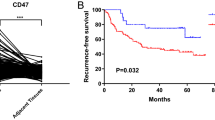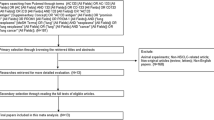Abstract
Objectives
Prior researches indicate that peripheral blood CD4 levels have an inverse correlation with distant tumor metastasis in non-small cell lung cancer (NSCLC). However, the linear relationship between CD4 and distant metastasis lacks clarity. Hence, the objective of this study was to ascertain the linear relationship between CD4 and distant metastasis in NSCLC patients.
Methods
This retrospective study analyzed clinical and laboratory data of NSCLC patients between March 2016 and July 2022 at the Cancer Hospital of Anhui University of Technology. The study first applied a generalized summation model and smoothing curve fitting to determine if there was a linear relationship between CD4 and NSCLC metastasis. Secondarily, univariate logistic analysis and multiple linear regression were used to analyze the odds ratio (OR) of CD4 as a continuous variable, dichotomous variable, and trichotomous variable when predicting NSCLC metastasis. In addition, stratified and subgroup analyses were conducted to assess the reliability of CD4 in different NSCLC patient populations.
Results
The study included a total of 213 NSCLC patients, among which 122 had distant metastasis and 91 had no metastasis. The smoothing curve fitting analysis revealed a U-shaped relationship between CD4 and NSCLC metastasis with a threshold effect. The univariate logistic analysis indicated that continuous CD4 expression was not significantly associated with NSCLC metastasis (P = 0.051); however, high levels of CD4 expression (≥ 35.06%) were found to be a protective factor against NSCLC metastasis when CD4+ T was a dichotomous variable (OR = 0.49, P = 0.010). Furthermore, multivariate linear regression models showed that low (< 32%) or high levels (> 44%) of CD4 significantly increased the risk of NSCLC metastasis compared to medium levels (32–44%) when CD4+ T was trichotomized. The significance was maintained in stratified analysis in relation to age, sex, type of pathology, smoke, PS, and T stage. CD4 levels were U-shaped in relation to different sites of distant metastases (bone, brain, liver), but not with lung metastases.
Conclusions
A threshold effect is shown to exist between the peripheral blood CD4 and distant metastasis in NSCLC patients. It was revealed that the risk of distant metastasis is lower when CD4 is maintained between 32 and 44%, whereas low (< 32%) or high (> 44) levels of CD4 are associated with an increased risk of distant metastasis in NSCLC patients.



Similar content being viewed by others
Data availability
The data set generated during this systematic review is available from the corresponding author on reasonable request.
References
Anichini A, Perotti VE, Sgambelluri F, Mortarini R (2020) Immune escape mechanisms in non small cell lung cancer. Cancers (Basel). https://doi.org/10.3390/cancers12123605
Asselain B, Barriere JR, Clarot C, Vabre JP, Gentil LPB, Duval Y, Thomas P, Herman D, Grivaux M, Debieuvre D (2019) Metastatic NSCLC: clinical, molecular, and therapeutic factors associated with long-term survival. Respir Med Res 76:38–44. https://doi.org/10.1016/j.resmer.2019.07.001
Braumuller H, Wieder T, Brenner E, Assmann S, Hahn M, Alkhaled M, Schilbach K, Essmann F, Kneilling M, Griessinger C, Ranta F, Ullrich S, Mocikat R, Braungart K, Mehra T, Fehrenbacher B, Berdel J, Niessner H, Meier F, van den Broek M, Haring HU, Handgretinger R, Quintanilla-Martinez L, Fend F, Pesic M, Bauer J, Zender L, Schaller M, Schulze-Osthoff K, Rocken M (2013) T-helper-1-cell cytokines drive cancer into senescence. Nature 494:361–365. https://doi.org/10.1038/nature11824
Burt P, Peine M, Peine C, Borek Z, Serve S, Flossdorf M, Hegazy AN, Hofer T, Lohning M, Thurley K (2022) Dissecting the dynamic transcriptional landscape of early T helper cell differentiation into Th1, Th2, and Th1/2 hybrid cells. Front Immunol 13:928018. https://doi.org/10.3389/fimmu.2022.928018
Chae YK, Chang S, Ko T, Anker J, Agte S, Iams W, Choi WM, Lee K, Cruz M (2018) Epithelial–mesenchymal transition (EMT) signature is inversely associated with T-cell infiltration in non-small cell lung cancer (NSCLC). Sci Rep 8:2918. https://doi.org/10.1038/s41598-018-21061-1
Chen Y, Cai C, Li Y (2021) The impact of baseline brain metastases on clinical benefits and progression patterns after first-line crizotinib in anaplastic lymphoma kinase-rearranged non-small cell lung cancer. Medicine (baltimore) 100:e24784. https://doi.org/10.1097/MD.0000000000024784
Eberst G, Vernerey D, Laheurte C, Meurisse A, Kaulek V, Cuche L, Jacoulet P, Almotlak H, Lahourcade J, Gainet-Brun M, Fabre E, Le Pimpec-Barthes F, Adotevi O, Westeel V (2022) Prognostic value of CD4+ T lymphopenia in non-small cell lung cancer. BMC Cancer 22:529. https://doi.org/10.1186/s12885-022-09628-8
Izem R, Liao J, Hu M, Wei Y, Akhtar S, Wernecke M, Macurdy TE, Kelman J, Graham DJ (2020) Comparison of propensity score methods for pre-specified subgroup analysis with survival data. J Biopharm Stat 30:734–751. https://doi.org/10.1080/10543406.2020.1730868
Kudo Y, Haymaker C, Zhang J, Reuben A, Duose DY, Fujimoto J, Roy-Chowdhuri S, Solis SL, Dejima H, Parra ER, Mino B, Abraham R, Ikeda N, Vaporcyan A, Gibbons D, Zhang J, Lang FF, Luthra R, Lee JJ, Moran C, Huse JT, Kadara H, Wistuba II (2019) Suppressed immune microenvironment and repertoire in brain metastases from patients with resected non-small-cell lung cancer. Ann Oncol 30:1521–1530. https://doi.org/10.1093/annonc/mdz207
Li X, Wen D, Li X, Yao C, Chong W, Chen H (2020) Identification of an immune signature predicting prognosis risk and lymphocyte infiltration in colon cancer. Front Immunol 11:1678. https://doi.org/10.3389/fimmu.2020.01678
Liu A, Xia Y, Li W, Zhang G, Liu Y, Ye S, Zhao ZR, Yang Y, Jia Y, Guo Y, Liu X, Chen H, Yu J (2022) The predictive value of changes in the absolute counts of peripheral lymphocyte subsets for progression and prognosis in breast cancer patients. Contrast Media Mol Imaging 2022:3444360. https://doi.org/10.1155/2022/3444360
Lorvik KB, Hammarstrom C, Fauskanger M, Haabeth OA, Zangani M, Haraldsen G, Bogen B, Corthay A (2016) Adoptive transfer of Tumor-Specific th2 cells eradicates tumors by triggering an in situ inflammatory immune response. Cancer Res 76:6864–6876. https://doi.org/10.1158/0008-5472.CAN-16-1219
Miao K, Zhang X, Wang H, Si X, Ni J, Zhong W, Zhao J, Xu Y, Chen M, Pan R, Wang M, Zhang L (2022) Peripheral blood lymphocyte subsets predict the efficacy of immune checkpoint inhibitors in non-small cell lung cancer. Front Immunol 13:912180. https://doi.org/10.3389/fimmu.2022.912180
Peron J, Cropet C, Tredan O, Bachelot T, Ray-Coquard I, Clapisson G, Chabaud S, Philip I, Borg C, Cassier P, Labidi GI, Sebban C, Perol D, Biron P, Caux C, Menetrier-Caux C, Blay JY (2013) CD4 lymphopenia to identify end-of-life metastatic cancer patients. Eur J Cancer 49:1080–1089. https://doi.org/10.1016/j.ejca.2012.11.003
Sellmer L, Kovacs J, Walter J, Kumbrink J, Neumann J, Kauffmann-Guerrero D, Kiefl R, Schneider C, Jung A, Behr J, Tufman A (2022) Markers of immune cell exhaustion as predictor of survival in surgically-treated early-stage NSCLC. Front Immunol 13:858212. https://doi.org/10.3389/fimmu.2022.858212
Shen DS, Yan C, Chen KH, Li L, Qu S, Zhu XD (2021) A nomogram based on circulating CD4(+) t lymphocytes and lactate dehydrogenase to predict distant metastasis in patients with nasopharyngeal carcinoma. J Inflamm Res 14:6707–6718. https://doi.org/10.2147/JIR.S341897
Tao CJ, Chen YY, Jiang F, Feng XL, Jin QF, Jin T, Piao YF, Chen XZ (2016) A prognostic model combining CD4/CD8 ratio and N stage predicts the risk of distant metastasis for patients with nasopharyngeal carcinoma treated by intensity modulated radiotherapy. Oncotarget 7:46653–46661. https://doi.org/10.18632/oncotarget.9695
Tran E, Turcotte S, Gros A, Robbins PF, Lu YC, Dudley ME, Wunderlich JR, Somerville RP, Hogan K, Hinrichs CS, Parkhurst MR, Yang JC, Rosenberg SA (2014) Cancer immunotherapy based on mutation-specific CD4+ T cells in a patient with epithelial cancer. Science 344:641–645. https://doi.org/10.1126/science.1251102
Tumeh PC, Hellmann MD, Hamid O, Tsai KK, Loo KL, Gubens MA, Rosenblum M, Harview CL, Taube JM, Handley N, Khurana N, Nosrati A, Krummel MF, Tucker A, Sosa EV, Sanchez PJ, Banayan N, Osorio JC, Nguyen-Kim DL, Chang J, Shintaku IP, Boasberg PD, Taylor EJ, Munster PN, Algazi AP, Chmielowski B, Dummer R, Grogan TR, Elashoff D, Hwang J, Goldinger SM, Garon EB, Pierce RH, Daud A (2017) Liver metastasis and treatment outcome with Anti-PD-1 monoclonal antibody in patients with melanoma and NSCLC. Cancer Immunol Res 5:417–424. https://doi.org/10.1158/2326-6066.CIR-16-0325
Urvay SE, Yucel B, Erdis E, Turan N (2016) Prognostic factors in stage III non-small-cell lung cancer patients. Asian Pac J Cancer Prev 17:4693–4697. https://doi.org/10.22034/apjcp.2016.17.10.4693
Yang C, Cheng H, Luo G, Lu Y, Guo M, Jin K, Wang Z, Yu X, Liu C (2017) The metastasis status and tumor burden-associated CA125 level combined with the CD4/CD8 ratio predicts the prognosis of patients with advanced pancreatic cancer: a new scoring system. Eur J Surg Oncol 43:2112–2118. https://doi.org/10.1016/j.ejso.2017.07.010
Ye L, Zhang F, Li H, Yang L, Lv T, Gu W, Song Y (2017) Circulating tumor cells were associated with the number of t lymphocyte subsets and NK cells in peripheral blood in advanced non-small-cell lung cancer. Dis Mark 2017:5727815. https://doi.org/10.1155/2017/5727815
Zanetti M (2015) Tapping CD4 T cells for cancer immunotherapy: the choice of personalized genomics. J Immunol 194:2049–2056. https://doi.org/10.4049/jimmunol.1402669
Zhang S, He Y, Xuan Q, Ling X, Men K, Zhao X, Xue D, Li L, Zhang Y (2022) TMEM139 prevents NSCLC metastasis by inhibiting lysosomal degradation of E-cadherin. Cancer Sci 113:1999–2007. https://doi.org/10.1111/cas.15341
Acknowledgements
We sincerely thank all participants for their help in this study. Thanks to Medical College of Anhui University of Science and Technology and Cancer Hospital of Huainan Oriental Hospital Group.
Funding
This study was supported by the National Natural Science Foundation of China (No. 81971483), the Collaborative Innovation Project of Colleges and Universities of Anhui Province (GXXT-2020-058), and the Graduate Innovation Foundation of AUST (2021CX2124, 2021CX2125, 2021CX2126). Open Research Fund of Anhui Province Engineering Laboratory of Occupational Health and Safety (No. AYZJSGCLK202202001, AYZJSGCLK202201001, AYZJSGCLK202201002). Open Research Fund of Key Laboratory of Industrial Dust Deep Reduction and Occupational Health and Safety of Anhui Higher Education Institutes (AYZJSGXLK202202002).
Author information
Authors and Affiliations
Contributions
HD and WJ: conception and design, and study supervision. HC, XZ, BY, ZJ, WW, GJ, and SZ: development of methodology, analysis, and interpretation of data, and writing of the manuscript. XY, XJ, and DX: review of the manuscript.
Corresponding authors
Ethics declarations
Conflict of interest
The authors have no relevant financial or non-financial interests to disclose.
Ethics statement
Ethical approval to report this case series was obtained from Cancer Hospital of Huainan Oriental Hospital Group Medical Research Ethics Committee (No: 2022-KY-FZZX-01).
Additional information
Publisher's Note
Springer Nature remains neutral with regard to jurisdictional claims in published maps and institutional affiliations.
Rights and permissions
Springer Nature or its licensor (e.g. a society or other partner) holds exclusive rights to this article under a publishing agreement with the author(s) or other rightsholder(s); author self-archiving of the accepted manuscript version of this article is solely governed by the terms of such publishing agreement and applicable law.
About this article
Cite this article
Bai, Y., Liu, Y., Wu, J. et al. CD4 levels and NSCLC metastasis: the benefits of maintaining moderate levels. J Cancer Res Clin Oncol 149, 16827–16836 (2023). https://doi.org/10.1007/s00432-023-05418-2
Received:
Accepted:
Published:
Issue Date:
DOI: https://doi.org/10.1007/s00432-023-05418-2




